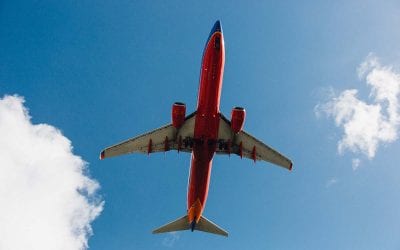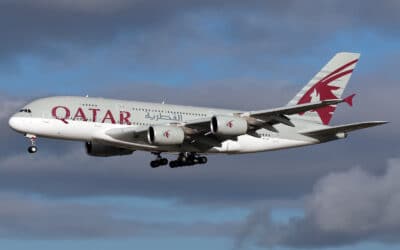While in-flight theft isn’t commonplace, it isn’t rare either. Air travelers must pack defensively to prevent theft of the cash, cards, identification, and other valuables they bring aboard their flights.
 In-flight theft is alive and well. Diego Sebastian Radio was on American Airlines flight 900 from Buenos Aires to Miami on July 5. A flight attendant observed him on the flight apparently acting in a suspicious manner. He was pacing up and down the aisle and sat in an unassigned seat at times. Alerted by the flight crew upon landing, passengers were met by law enforcement and U.S. Customs and Border Protection (CBP) agents.
In-flight theft is alive and well. Diego Sebastian Radio was on American Airlines flight 900 from Buenos Aires to Miami on July 5. A flight attendant observed him on the flight apparently acting in a suspicious manner. He was pacing up and down the aisle and sat in an unassigned seat at times. Alerted by the flight crew upon landing, passengers were met by law enforcement and U.S. Customs and Border Protection (CBP) agents.
The CBP agents inspected Radio’s belongings and reportedly found $10,732 in cash, which equaled the amount two passengers said was missing from their bags. They also found two credit cards that belonged to one of the two passengers in a pocket in his jacket. Upon questioning, faced with the evidence, Radio has apparently admitted to stealing the cash and credit cards.
I’ve got 15 commonsense actions for you to prevent in-flight theft of your belongings:
If it’s really valuable, leave it at home.
If you can’t afford to lose it:
The best advice I can give anyone about preventing theft of their belongings while traveling is,
“If you can’t afford to have something lost or stolen, leave it at home.”
Aircraft closets and bulkhead hangers:
In many first and business class cabins, small closets or bulkhead hangers are available to hang passengers’ coats and jackets. If you have yours hung up, make sure you empty their pockets first.
Unless you have to carry a large sum of cash while traveling, get it from an ATM at your destination, as you need it, to prevent large cash thefts.
Carrying cash, credit cards and identification:
For most travelers, carrying large amounts of cash isn’t necessary. While traveling, I suggest paying your bills for goods and services by credit/debit card rather than cash. When you need cash, I recommend going to a safe ATM to obtain only the cash you need for a day or so. If you have to have cash, keep it on your person. Consider using a neck wallet or money belt.
Never pack your credit/debit cards or identification in your carry-on or personal item. I carry my cards and IDs in an out-of-sight neck wallet when traveling.
To pay for in-flight purchases:
Virtually no airlines accept cash for in-flight purchases any more. In-flight, keep your cash, cards and identification hidden, out of view. For purchases, keep a single credit/debit card in a zippered or buttoned front pocket for quick access if needed.
Airplane seat pockets:
It’s very easy for thieves to casually grab your belongings from the seat pocket in front of you while you sleep. Don’t ever use them to temporarily stow your valuables. They’re generally too filthy to use anyway.
When stowing your carry-on in an overhead bin, use a location you can easily monitor.
Stowing your carry-on in the overhead bin:
Stow your carry-on in an overhead bin location that’s viewable from your seat. The best place to stow it is slightly in front of you, in the bin on the other side of the aisle from your seat. If that’s not possible, make sure that you at least keep it overhead or in front of you, never behind you in a bin.
I may be overly suspicious, but be extremely wary of passengers who aren’t seated anywhere near you, who place their carry-on next to yours soon after you stow your bag. The location gives them an excuse to get near your bag. That gives them an opportunity to rifle through it.
Lock your carry-on:
Before you stow your carry-on, lock it. Make it as hard as possible for thieves to quickly get into your bag, find valuable items and take them. If your bag is locked, a thief is more likely to try someone else’s unlocked bag.
At least zip up your bag:
If you haven’t gotten a lock for your carry-on before your fly again, at least zip your bag completely before you stow it in the overhead bin, or under the seat in front of you. An unzipped bag may be a bit more convenient to use, but it’s an open invitation for thieves.
Never put anything valuable in the outside pockets of any of your bags.
Don’t put valuables in outside pockets:
The outside pockets of many carry-on bags can’t be locked and are easy to quickly open. Don’t store your valuables, cash, credit/debit cards or identification in them. The only things I pack in carry-on outside pockets are some clothes and a hat, if anything.
If you must pack valuables:
Airlines don’t accept liability for valuables or breakables packed in your bags. Therefore, in-flight theft can hit you hard. Therefore, avoid packing them in your checked luggage because they’re too often mishandled. Valuables that you need to pack for your journey should go in your carry-on. When packing valuables, place them as deeply among your belongings as possible. Use packing bags and cubes for organization and to keep them hidden from prying eyes when your bag must be opened to retrieve an item in-flight.
Repeatedly checking your valuables in the plane:
Repeatedly checking to see if your valuables are still safe in your bag while in-flight won’t make them safer. It can alert those around you in the plane that you’ve packed something of value in your bag and pin a target on your carry-on. (It’s a good idea to not repeatedly check your valuables in the airport for the same reason.)
If you’re flying alone:
If you’re traveling alone and need to use the lavatory, take your personal item with you into the lavatory. Personal items are too easily snatched when unattended. You can’t depend on strangers sitting beside you to protect your belongings.
When you sleep, your personal item is particularly vulnerable to in-flight theft.
When you sleep:
If you need to sleep on your flight, the suggestions I’ve offered above will give some protection for the belongings packed in your carry-on. On the other hand, your personal item which is smaller and lighter is still highly vulnerable while you sleep. I keep my personal item’s strap wrapped around my foot/leg while I’m dozing. If someone touches it, that will awaken me. Few thieves will chance it.
If your valuables are especially vulnerable:
As a photographer, I bring my camera bodies and lenses, computer and other gear in my backpack not just because they’re valuable, but also because I’ve got to have them immediately upon landing. Putting them in checked luggage is far too risky. To protect them in my photo backpack I put the backpack in a PacSafe Anti-Theft Protector. Even if a thief manages to unlock my bag, the Pacsafe prevents the backpack from being opened and stops my gear from being slipped out.
If you’ve been robbed in-flight, report it to the flight crew, even if it’s embarrassing.
If you’ve been robbed:
While using your carry-on or personal item in-flight, if you notice something is missing, immediately report it to a flight attendant. Particularly if they’ve noticed suspicious activity by a passenger, they can call ahead to have the authorities at your destination airport meet the plane and investigate.
Whenever you’re flying, remember your plane is just like being out on the streets of your destination. There are people on the street and in your plane who will take advantage of the situation and travelers’ vulnerabilities. Use my list of actions to reduce your susceptibility to in-flight theft and protect your belongings.
(Image: American Airlines A319 landing at Philadelphia International Airport. Copyright © 2018 NSL Photography. All Rights Reserved.)

READ ALSO:
Know these four international air travel rights and save
Aircraft vs. lightning is scary, but planes are safe
After many years working in corporate America as a chemical engineer, executive and eventually CFO of a multinational manufacturer, Ned founded a tech consulting company and later restarted NSL Photography, his photography business. Before entering the corporate world, Ned worked as a Public Health Engineer for the Philadelphia Department of Public Health. As a well known corporate, travel and wildlife photographer, Ned travels the world writing about travel and photography, as well as running photography workshops, seminars and photowalks. Visit Ned’s Photography Blog and Galleries.



